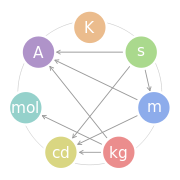Becquerel
The becquerel (symbol Bq) is the SI derived unit of radioactivity. One Bq is defined as the activity of a quantity of radioactive material in which one nucleus decays per second. The Bq unit is therefore equivalent to s−1. The becquerel is named for Henri Becquerel, who shared a Nobel Prize with Pierre and Marie Curie for their work in discovering radioactivity.
In a fixed mass of radioactive material, the number of becquerels changes with time. Therefore, a sample radioactive decay rate is always stated with a timestamp for short-lived isotopes, sometimes after adjustment to some specific date of interest (in the past or in the future). For example, one might quote a ten-day adjusted figure, that is, the amount of radioactivity that will still be present ten days in the future. This can de-emphasize short-lived isotopes.
SI uses the becquerel rather than the second for the unit of activity measure to avoid dangerous mistakes: a measurement in becquerels is proportional to activity, and thus a more dangerous source of radiation gives a higher reading. A measurement in seconds is inversely proportional.
The becquerel can be used for the frequency of aperiodic or stochastic events; that is, events which occur randomly and cannot be exactly predicted. For periodic events, the hertz, which is also defined as s−1, is used as a unit.
Contents |
Prefixes
As any SI unit, Bq can be prefixed; commonly used multiples are kBq (kilobecquerel, 103 Bq), MBq (megabecquerel, 106 Bq), GBq (gigabecquerel, 109 Bq), TBq (terabecquerel, 1012 Bq), and PBq (petabecquerel, 1015 Bq). For practical application, 1 Bq is a small unit; therefore, the prefixes are common. For example, natural potassium (40K) in a typical human body produces 4,000 disintegrations per second (i.e., 4 kBq of activity).[1] The nuclear explosion in Hiroshima (14 kt or 59 TJ) is estimated to have produced 8×1024 Bq.[2]
Bq versus counts per second
When measuring radioactivity of a sample with a detector, a unit of "counts per second" (cps) or "counts per minute" (cpm) are often used. These units can be converted to the absolute activity of the sample in Bq if one applies a number of significant conversions, e.g., for the radiation background, for the detector efficiency, for the counting geometry, for self-absorption of the radiation in the sample.
Relationship to the curie
The curie (Ci) is an older, non-SI unit of radioactivity.
The conversion factors are:
- 1 Ci = 3.7×1010 Bq
and
- 1 Bq = 2.70×10−11 Ci
Definition
1 Bq = 1 s−1
This SI unit is named after Henri Becquerel. As with every SI unit whose name is derived from the proper name of a person, the first letter of its symbol is uppercase (Bq). When an SI unit is spelled out in English, it should always begin with a lowercase letter (becquerel), except where any word would be capitalized, such as at the beginning of a sentence or in capitalized material such as a title. Note that "degree Celsius" conforms to this rule because the "d" is lowercase.—Based on The International System of Units, section 5.2.
References
- ↑ Radioactive human body — Harvard University Natural Science Lecture Demonstrations
- ↑ Michael J. Kennish, Pollution Impacts on Marine Biotic Communities , CRC Press, 1998, p. 74. ISBN 9780849384288.
External links
- Derived units on the International Bureau of Weights and Measures (BIPM) web site
|
||||||||||||||||||||
